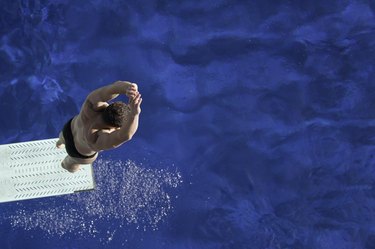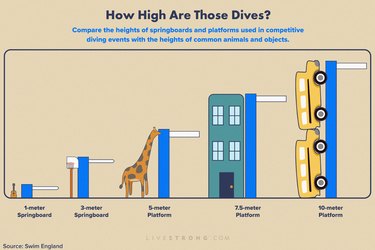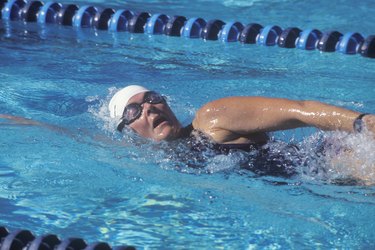
When you think about competitive diving, you might imagine two perfectly synchronized divers leaping into the water from a platform. And while the synchronized dive is a popular event, diving has plenty more to offer.
But how many events does diving include exactly? Why do some athletes jump off a board, while others leap from a platform? And — what everyone probably wonders while watching diving — how fast are they going when they hit the water?
Video of the Day
Video of the Day
Jump headfirst into these competitive diving statistics to learn more about this graceful (yet intense) sport.
Tip
Like many other sports, diving typically categorizes athletes as women or men, which is why we've used these terms below.
Competitive Diving Events
Competitive diving is more than just jumping into a pool. There are two different categories of dives: springboard and platform. From there, the sport is broken down into synchronized and individual competitions. There are four different events in competitive diving, which are in turn broken down into six different groups, depending on the way a diver chooses to jump from the board.
- The springboard diving events for men and women are:
- 1-meter springboard
- 3-meter springboard
- The heights for competitive diving platforms, according to Swim England, are:
- 5 meters
- 7.5 meters
- 10 meters
- Competitive diving consists of six different groups, according to Team USA, which describe the direction the diver jumps or their starting position on the diving board. They are:
- Forward group
- Backward group
- Reverse group
- Inward group
- Twisting group
- Armstand group
- Synchronized diving, one type of competitive diving, has four different men's and women's events, either from a 3-meter board or a platform:
- Men's synchro 3-meter
- Men's synchro platform
- Women's synchro 3-meter
- Women's synchro platform
- There are four different positions that an athlete can perform during their dive:
- Pike
- Tuck
- Straight
- Free

Competitive Diving Score Statistics
Judges score an athlete based on every part of their dive, from the approach to the board to their entry into the water. Then, judges rate the athlete's overall performance from 1 to 10.
- There are five categories judges use to critique a dive, according to Team USA:
- Approach to the end of the board
- Takeoff from the board
- Elevation from the board into the air
- Execution of the different positions in the dive
- Entry into the water
Criteria for Diving Scores
Points | Meaning |
|---|---|
10 | Excellent |
8.5-9.5 | Very good |
7-8 | Good |
5-6.5 | Satisfactory |
2.5-4.5 | Deficient |
.5-2 | Unsatisfactory |
0 | Completely failed |
Olympic Diving Events
Competitive diving is a popular sport in the summer Olympic Games. The Games have four different competitive diving events, divided into two individual categories.
- Olympic diving has two categories, according to the official Tokyo 2020 website:
- Springboard diving
- Platform diving
- The four diving events in the Olympics are:
- 3-meter springboard (men and women)
- 10-meter platform (men and women)
- Synchronized 3-meter platform (men and women)
- Synchronized 10-meter platform (men and women)
Meet the U.S. Olympic Diving Team
Competitive Diving Records
Although diving is not as popular as swimming in the U.S., the sport is competitive at both the collegiate and professional levels.
NCAA Diving Records
Take a look at the current National Collegiate Athletic Association (NCAA) competitive diving records.
Division I
- 1-Meter Dive:
- Men's: N/A
- Women's: Megan Neyer, 495.85 (1983)
- 3-Meter Dive:
- Men's: N/A
- Women's: Yulia Pakhalina, 657.30 (2003)
Division II
- 1-Meter Dive:
- Men's: Dario DiFazio, 618.70 (1994)
- Women's: Kayla Kelosk, 511.15 (2011)
- 3-Meter Dive:
- Men's: Ammar Hassan, 624.80 (2018)
- Women's: Elizabeth Rawlings, 555.70 (2015) 555.70
Division III
- 1-Meter Dive:
- Men's: Connor Dignan, 578.70 (2014)
- Women's: Danica Roskos, 515.90 (2011)
- 3-Meter Dive:
- Men's: N/A
- Women's: Hayley Emerick, 517.10 (2010)
U.S. 2020 Olympic Diving Statistics
These are the medals that the U.S. diving team brought home in the most recent Summer Olympics, the 2020 Tokyo Olympic Games, according to the official Olympics website.
Silver Medals
- Men's 3-meter synchronized springboard: Andrew Capobianco and Mike Hixon, 444.36
- Women's 10-meter synchronized platform: Delaney Schnell and Jessica Parratto, 310.80
Bronze Medal
Women's 3-meter springboard: Krysta Palmer, 343.75
Top U.S. Olympic Divers
Team USA Diving Demographics
Although the national diving is relatively small, compared to swimming, for instance, USA Diving has taken steps in making the team more inclusive.
- There are 92 athletes of color on the national diving team, according to USA Diving's 2021 Diversity and Inclusion Scorecard. That's 29 more athletes than in 2019, according to USA Diving's 2019 scorecard.
- 55 national team coaches are people of color in 2021, compared to 35 in 2019.
- There are 63 women athletes on the 2019 national team, compared to 25 in 2018.
- 55 national team coaches were women in 2021, compared to 35 in 2019.
Diving Injury Statistics
Although divers use specific hand positions to protect themselves, injuries still happen. Considering most divers train about 40 hours per week on average, many injuries are related to overuse of certain muscles and joints, according to a September 2017 article in Current Sports Medicine Reports. But head-related injuries are a potential risk, too.
- Divers use two hand positions to minimize impact when they land in the water, according to the Current Sports Medicine Reports article:
- Thumb-in-palm position: wrapping one palm around the opposite thumb
- Flat-hand grab position: wrapping one palm around the opposite hand
- Back injuries are the most common type of diving injury.
- Divers over the age of 13 have a 45% chance of experiencing back pain after a year of competing, according to a small but often-cited January 2006 study in Knee Surgery, Sports Traumatology, Arthroscopy.
- 32% of injured male divers and 16.2% of injured female divers got hurt when they made contact with the water, according to a June 2020 study in The Sport Journal.
- Diving injury statistics by sex, according to the Shepherd Center, a non-profit hospital, break down as follows:
- 15% in women
- 85% in men
- There were 12,096 head injuries due to water sports (including diving) in 2007, according to Newsome Melton, a brain and spinal cord rehabilitation center. (That's much fewer than cycling, with 64,993, and football, with 36,412.)
Where Do Diving Injuries Take Place?
Location | Percentage of Injuries |
|---|---|
Pool | 42.4% |
Ocean | 30.3% |
Lake | 15.2% |
River | 6.1% |
Pond | 3% |
Unknown | 3% |
Historical Diving Facts
Although the sport has been on the Olympic scene for quite some time, synchronized diving specifically is a relatively new event.
- Diving first became an Olympic sport at the 1904 St. Louis Games, according to British Swimming.
- Previously, synchronized diving was only held at diving shows. The event became a part of the Olympics at the 2000 Sydney Games, according to Team USA.
- Switzerland's Lazaro Schaller holds the record for the highest dive at 58.8 meters, according to Guinness World Records.
How Fast Do Divers Hit the Water?
Divers generally hit the water at about 40 miles per hour, according to the American Academy of Pediatrics. That's enough force to break bones or dislocate joints, which is why form is so important for safety in this sport.
Diving Pool Statistics
All competitive swimming pools must meet specific measurements and regulations to be considered valid for competitive diving.
- The current pool depth requirements are:
- Competition Pool: 5 meters deep with a 10-meter platform
- Diving Pool: 5 meters deep with a 5-meter platform or 3-meter springboard
- The Olympic springboard is 3 meters high above the water and extends 5 feet over the water, according to NBC Olympics.
- The springboard is .5 meters wide and 4.8 meters long.
- Swim England: "About Platform and Springboard Diving"
- Team USA: "Dive Groups"
- Team USA: "Judging and Scoring"
- Olympics: "Diving"
- NCAA: "Swimming and Diving"
- USA Diving: "2019 D&U Scorecard"
- Science Daily: "Competitive Divers Face High Risk of Back, Shoulder and Other Injuries"
- Current Sports Medicine Reports: "Competitive Diving Principles and Injuries"
- The Sport Journal: "High School Competitive Diving Injuries: National Athletic Treatment Injury and Outcomes Network (NATION)"
- Shepherd Center: "Diving Injuries"
- Newsome Melton: "Brain Injury Statistics"
- American Academy of Pediatrics: "Diving"
- British Swimming: "History of Diving"
- Guinness World Records: "Highest Dive From a High Diving Board"
- USA Diving: "2021 D&I Scorecard"
- NBC Olympics: "Diving 101: Equipment"
- Tokyo 2020 Diving Results
- National Collegiate Athletic Association: "NCAA's Men's and Women's Swimming and Diving Records"




